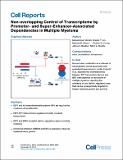| dc.contributor.author | Fulciniti, Mariateresa | |
| dc.contributor.author | Lin, Charles Y. | |
| dc.contributor.author | Samur, Mehmet K. | |
| dc.contributor.author | Lopez, Michael A. | |
| dc.contributor.author | Singh, Irtisha | |
| dc.contributor.author | Lawlor, Matthew A. | |
| dc.contributor.author | Szalat, Raphael E. | |
| dc.contributor.author | Ott, Christopher J. | |
| dc.contributor.author | Avet-Loiseau, Herve’ | |
| dc.contributor.author | Anderson, Kenneth C. | |
| dc.contributor.author | Young, Richard A. | |
| dc.contributor.author | Bradner, James E. | |
| dc.contributor.author | Munshi, Nikhil C. | |
| dc.date.accessioned | 2020-11-02T23:31:10Z | |
| dc.date.available | 2020-11-02T23:31:10Z | |
| dc.date.issued | 2018-12 | |
| dc.date.submitted | 2018-10 | |
| dc.identifier.issn | 2211-1247 | |
| dc.identifier.uri | https://hdl.handle.net/1721.1/128288 | |
| dc.description.abstract | The relationship between promoter proximal transcription factor-associated gene expression and super-enhancer-driven transcriptional programs are not well defined. However, their distinct genomic occupancy suggests a mechanism for specific and separable gene control. We explored the transcriptional and functional interrelationship between E2F transcription factors and BET transcriptional co-activators in multiple myeloma. We found that the transcription factor E2F1 and its heterodimerization partner DP1 represent a dependency in multiple myeloma cells. Global chromatin analysis reveals distinct regulatory axes for E2F and BETs, with E2F predominantly localized to active gene promoters of growth and/or proliferation genes and BETs disproportionately at enhancer-regulated tissue-specific genes. These two separate gene regulatory axes can be simultaneously targeted to impair the myeloma proliferative program, providing an important molecular mechanism for combination therapy. This study therefore suggests a sequestered cellular functional control that may be perturbed in cancer with potential for development of a promising therapeutic strategy. | en_US |
| dc.publisher | Elsevier BV | en_US |
| dc.relation.isversionof | http://dx.doi.org/10.1016/j.celrep.2018.12.016 | en_US |
| dc.rights | Creative Commons Attribution-NonCommercial-NoDerivs License | en_US |
| dc.rights.uri | http://creativecommons.org/licenses/by-nc-nd/4.0/ | en_US |
| dc.source | Elsevier | en_US |
| dc.title | Non-overlapping Control of Transcriptome by Promoter- and Super-Enhancer-Associated Dependencies in Multiple Myeloma | en_US |
| dc.type | Article | en_US |
| dc.identifier.citation | Fulciniti, Mariateresa et al. “Non-Overlapping Control of Transcriptome by Promoter- and Super-Enhancer-Associated Dependencies in Multiple Myeloma.” Cell Reports 25, 13 (December 2018): 3693–3705.e6 © 2018 Elsevier | en_US |
| dc.contributor.department | Massachusetts Institute of Technology. Department of Biology | en_US |
| dc.relation.journal | Cell Reports | en_US |
| dc.eprint.version | Final published version | en_US |
| dc.type.uri | http://purl.org/eprint/type/JournalArticle | en_US |
| eprint.status | http://purl.org/eprint/status/PeerReviewed | en_US |
| dc.date.updated | 2019-02-28T13:38:55Z | |
| dspace.orderedauthors | Fulciniti, Mariateresa; Lin, Charles Y.; Samur, Mehmet K.; Lopez, Michael A.; Singh, Irtisha; Lawlor, Matthew A.; Szalat, Raphael E.; Ott, Christopher J.; Avet-Loiseau, Herve’; Anderson, Kenneth C.; Young, Richard A.; Bradner, James E.; Munshi, Nikhil C. | en_US |
| dspace.embargo.terms | N | en_US |
| dspace.date.submission | 2019-04-04T12:55:36Z | |
| mit.journal.volume | 25 | en_US |
| mit.journal.issue | 13 | en_US |
| mit.license | PUBLISHER_CC | en_US |
| mit.metadata.status | Complete | |
